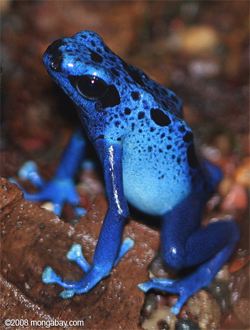52% of amphibians, 35% of birds at risk from climate change
mongabay.com
October 8, 2008
|
|
52 percent of the amphibians, 35 percent of birds and 71 percent of reef-building coral are “particularly susceptible” to climate change, warns an IUCN report.
The research, released at the World Conservation Congress in Barcelona, identified more than 90 biological traits — including specialized habitat requirements, limited dispersal ability and water-dependent larvae — which are thought to make species most susceptible to climate change. It reports that 3,438 of the world’s 9,856 bird species, 3,217 of 6,222 amphibians, and 566 of 799 warm-water reef-building coral species have traits that put them at risk to the effects of climate shifts.
“Climate change is already happening, but conservation decision makers currently have very little guidance on which species are going to be the worst affected,” said Wendy Foden, of IUCN’s Species Program.
 |
The new research shows that while a large proportion of threatened species are especially at risk from climate change, some species that are currently faring well could see threats in the near future from global change. For example, according to the IUCN Red List, about one third of amphibians are threatened with extinction. 75 percent of these susceptible to climate change as are 41 percent of non-threatened species. For birds, 12 percent of non-threatened species are susceptible.
“There is a large overlap between threatened and climate change susceptible amphibian and bird species,” says Jean-Christophe Vié, Deputy Head of IUCN Species Programme. “Climate change may cause a sharp rise in the risk and rate of extinction of currently threatened species. But we also want to highlight species which are currently not threatened but are likely to become so as climate change impacts intensify. By doing this we hope to promote preemptive and more effective conservation action.”